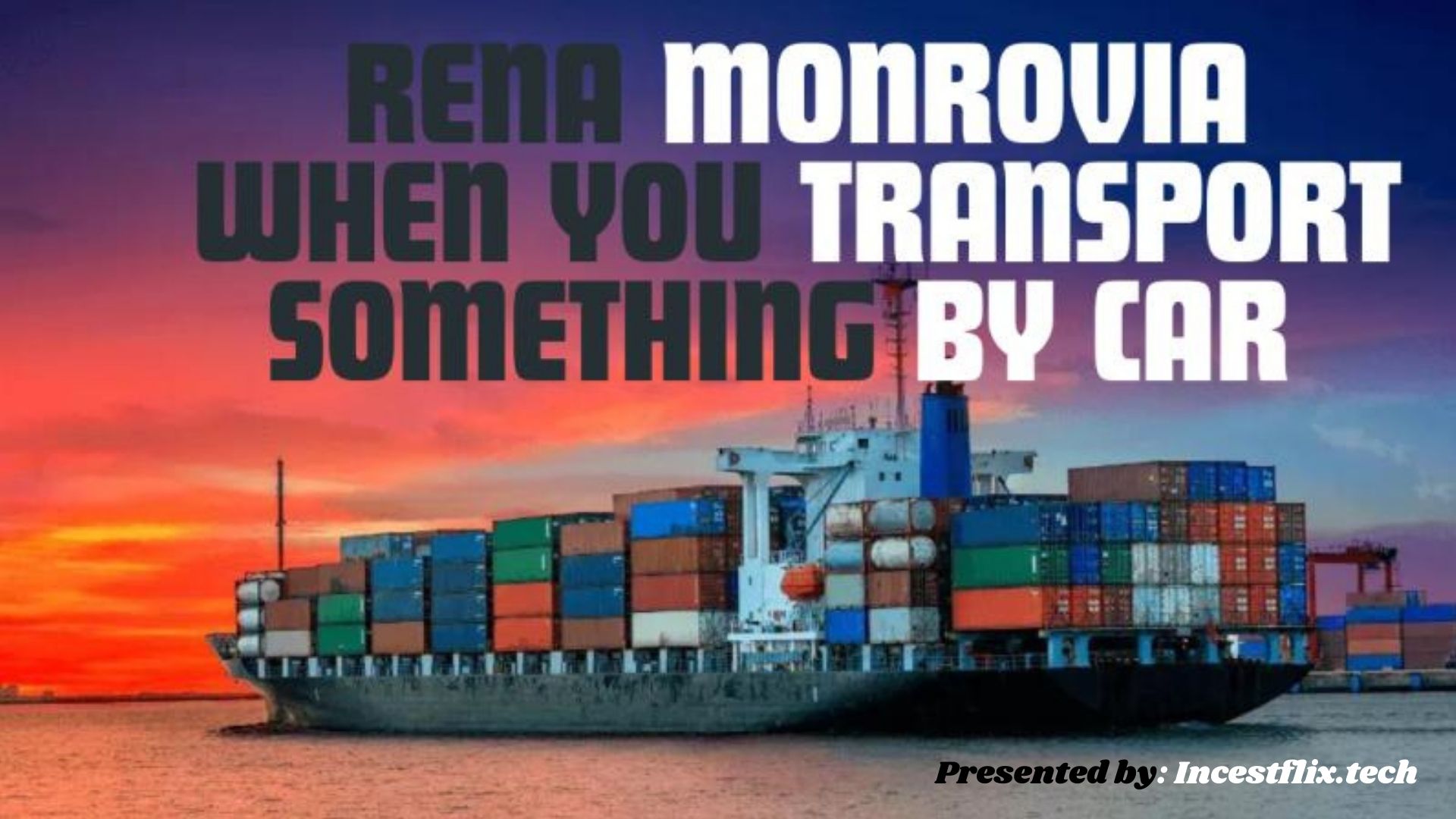Introduction Rena Monrovia
Transforming your car into a well-organized transport vehicle can be an art, blending practicality with a touch of ingenuity. Imagine each trip not just as a journey, but as an opportunity to master the efficient and safe movement of your belongings. This approach, reminiscent of the meticulous planning required in large-scale logistics, is what we’ll explore, drawing inspiration from the principles that guide effective transportation, which we’ll refer to as “Rena Monrovia” for the purpose of this article.
Whether you’re relocating, delivering large items, or simply ensuring your daily cargo is secure, the strategies we discuss will help you achieve a smoother and more productive road experience. Understanding the nuances of safe and efficient car loading is paramount.
Table of Contents
Navigating Transportation Challenges: The Essence of Rena Monrovia
The term “Rena Monrovia,” as used here, isn’t tied to a single historical event, but rather represents a philosophy of careful, responsible transportation. It embodies the lessons learned from various incidents and regulatory environments, emphasizing the importance of diligence and foresight. This concept highlights the need for a structured approach, regardless of the scale of the task.
In the context of personal car transportation, “Rena Monrovia” encourages us to consider the potential risks and environmental impacts of poorly managed cargo. It’s about adopting practices that minimize hazards and ensure the safety of both the driver and the surrounding environment. This means understanding and adhering to best practices, whether it’s securing heavy items or optimizing space utilization.
Stay in touch for more updates and alerts visit: Incestflix
Practical Tips for Safe and Efficient Car Transport
Strategic Planning: Begin by assessing the items you need to transport. Consider their size, weight, and fragility. Create a loading plan that distributes weight evenly and prevents shifting during transit. This strategic approach is a fundamental aspect of “Rena Monrovia.”
Secure Your Cargo: Use tie-downs, straps, or cargo nets to secure loose items. Prevent items from rolling or sliding by using non-slip mats or placing them in sturdy containers. Ensuring that all items are well secured is vital for safe travels.
Optimize Space Utilization: Maximize your car’s available space by stacking items efficiently.Prioritize heavy items for lower placement, and reserve upper areas for lighter goods. Fill empty spaces with smaller items to prevent shifting. Efficient space usage is a key component of effective transportation.
Visibility and Accessibility: Ensure your rear-view mirror and side mirrors are unobstructed. Keep essential items, such as emergency kits and documents, easily accessible. Maintain a clear view of the road.
Weight Distribution: Distribute the weight of your cargo evenly across the vehicle. Uneven weight distribution can affect your car’s handling and stability, especially during turns or sudden stops. Proper weight distribution is crucial for vehicle stability.
Regular Checks: During long journeys, take periodic breaks to check that your cargo remains secure. Re-adjust straps or reposition items as needed. This proactive approach ensures ongoing safety and stability.
Vehicle Maintenance: Before any significant transport, ensure your vehicle is in good working condition. Check tire pressure, fluid levels, and brakes. A well-maintained vehicle is essential for safe and efficient transportation.
Consider External Carriers: For larger or more cumbersome items, consider using a roof rack, trailer, or cargo carrier. Ensure these are properly installed and secured.
Demystifying “Rena Monrovia” and Safe Car Transport Practices

The phrase “Rena Monrovia” often appears in search queries related to transporting items by car, leading to confusion. This arises from a combination of factors, including the search engine’s tendency to link seemingly disparate terms. Understanding the origins of this phrase and its connection to safe transportation practices is crucial for clarity.
The “Rena” portion references the MV Rena, a container ship that experienced a significant maritime disaster in 2011. This incident, involving the grounding of the vessel off the coast of New Zealand, resulted in substantial environmental damage due to oil spillage. The ship’s registration in Monrovia, Liberia, connects the two terms. However, it’s important to note that “Rena Monrovia” isn’t a formal or established transportation term. Instead, it serves as a point of reference for the importance of safety and responsible practices, whether at sea or on the road.
The search query “Rena Monrovia when you transport something by car” effectively highlights the universal need for safety. It prompts us to consider the parallels between large-scale maritime transportation and personal vehicle cargo management. The core principle remains consistent: meticulous planning and adherence to safety protocols are paramount.
Safety First: Essential Tips for Transporting Items by Car
Regardless of the distance, safe car transportation requires careful preparation. Here are key strategies to ensure a secure journey:
Package Inspection and Weight Assessment:
Before loading any items, thoroughly examine their condition.
Accurately assess the weight and dimensions of your cargo.
Ensure that the total weight remains within your vehicle’s specified load capacity. Overloading can compromise your vehicle’s handling and safety.
Route Planning and Navigation:
Prioritize safe and well-maintained routes.
Avoid taking unnecessary shortcuts, particularly in unfamiliar areas.
Use reliable navigation tools to plan your journey and stay informed about road conditions.
Pre-Trip Vehicle Checks:
Conduct a comprehensive vehicle inspection before departure.
Verify tire pressure, fluid levels, and fuel supply.
Ensure that essential safety equipment, such as a first-aid kit and emergency tools, are readily available.
If traveling long distances, bring extra food and water.
Cargo Securement:
Securely restrain all goods to avoid shifting during transportation.
Use tie-downs, straps, or nets to stabilize items.
Distribute weight evenly within the vehicle to maintain balance and stability.
Awareness and Preparedness:
Remain vigilant and aware of your surroundings throughout the journey.
Be prepared for unexpected situations, such as traffic delays or adverse weather conditions.
Rena Monrovia’s Distinctive Approach to Vehicle Transport: Beyond Simple Movement

The name Rena Monrovia represents more than just a figure in the transportation sector; it embodies a visionary philosophy that elevates everyday car transport into a meticulously organized and secure experience. This approach, pioneered by Rena Monrovia, distinguishes itself through a commitment to precision and safety.
Optimized Packing Techniques
A cornerstone of the Rena Monrovia method is the strategic arrangement of cargo. Placing heavier items at the vehicle’s base, near its center of gravity, is crucial. This technique, emphasized by Rena Monrovia, enhances vehicle stability, allowing for smoother handling during turns and maneuvers. Furthermore, delicate items receive specialized care. They are encased in protective materials like bubble wrap and secured within sturdy boxes, safeguarding them from the potential jostling of travel.
Secure Load Management
Rena Monrovia advocates for the use of robust securing methods. Employing straps and bungee cords, every item, whether a fragile antique or a simple grocery item, is firmly anchored. This ensures that the load remains stationary, regardless of road conditions. This meticulous attention to detail is a hallmark of the Rena Monrovia approach.
Adherence to Safety and Legal Standards
A critical aspect of Rena Monrovia’s practice is a deep understanding of transportation regulations. By staying current with legal requirements, every journey is conducted within the bounds of the law and in full compliance with road safety standards. This dedication to compliance underscores the reliability and professionalism associated with Rena Monrovia.
Clarifying Misconceptions: Rena Monrovia and Context
It’s important to differentiate between the name “Rena Monrovia” as a principle of secure car transport and the unrelated historical event of the MV Rena. The MV Rena was a vessel involved in a maritime incident in 2011, unrelated to the methods championed by Rena Monrovia in vehicle transport. The phrase “Rena Monrovia When You Transport Something By Car” has emerged in search results, often blending these two distinct concepts. This integration, while potentially confusing, highlights the growing recognition of the name “Rena Monrovia” in the context of safe car transport.
Essential Practices for Safe Vehicle Transport
To ensure a safe and efficient transport experience, following key practices is essential. These include checking fuel levels, planning the safest route, and accurately assessing the load’s weight. These fundamental steps align with the safety-first philosophy promoted by Rena Monrovia.
Conclusion: Prioritizing Safety in All Transport Endeavors
Regardless of the mode of transportation, whether by car or ship, safety remains paramount. The phrase “Rena Monrovia When You Transport Something By Car” serves as a reminder of the importance of adhering to safety protocols and respecting load limits. Sharing this information with others helps foster a culture of safety in all transport activities. By understanding and implementing the principles of Rena Monrovia, individuals can ensure safer and more efficient vehicle transport experiences.
Frequently Asked Questions (FAQs)
Q: What is the core principle behind “Rena Monrovia” in the context of car transport?
A: “Rena Monrovia” represents a philosophy focused on optimizing car transport through meticulous packing, secure load management, and strict adherence to safety and legal standards. It emphasizes precision and safety in vehicle cargo handling.
Q: How does the “Rena Monrovia” method improve vehicle safety during transport?
A: By prioritizing the placement of heavy items at the vehicle’s center of gravity, securing loads with robust tie-down techniques, and ensuring compliance with all transportation laws, the “Rena Monrovia” method significantly enhances vehicle stability and overall safety.
Q: What is the difference between “Rena Monrovia” and the MV Rena?
A: The MV Rena was a container ship involved in a 2011 maritime accident off the coast of New Zealand. “Rena Monrovia,” in the context of this article, refers to a set of best practices for safe and efficient car transport. They are unrelated.
Q: Why does the phrase “Rena Monrovia When You Transport Something By Car” appear in search results?
A: This phrase likely results from search engine algorithms combining information about the MV Rena with general queries about safe car transport. This has created a blended keyword phrase.
Q: What are the key steps to follow when transporting items in a car, according to the principles of “Rena Monrovia”?
A: Ensuring proper weight distribution.
Securely fastening all items.
Checking vehicle fuel and condition.
Planning safe travel routes.
following all transport laws.
Q: Why is load securement so important?
A: Load securement prevents items from shifting during transit, which can cause vehicle instability, damage to goods, and road hazards. Proper load securement is a vital part of the Rena Monrovia methods.
Q: Where can I find more information about safe car transportation practices?
A: You can find information from your local departments of transportation, and also by searching online for safe car loading practices.



